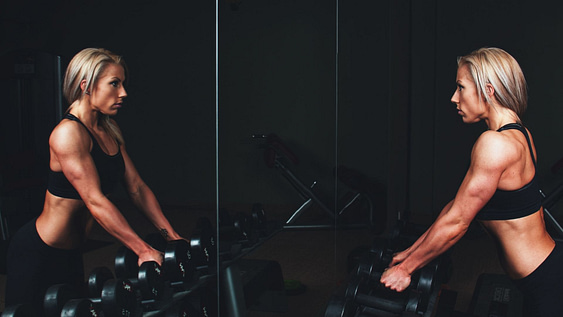Are you familiar with that invigorating sensation of strength coursing through your body after a set of squats? If you’ve ever wondered, “Why do squats make me feel stronger?” you’re in the right place.
Squats, a fundamental exercise in weightlifting and fitness, have earned their reputation as one of the most effective movements for building strength.
But what exactly happens during squats that triggers this empowering feeling? Let’s dive into the science and explore the factors contributing to the strength-boosting magic of squats.
Squats make you feel stronger because they engage multiple muscle groups, including your quadriceps, hamstrings, glutes, and core. This compound exercise stimulates muscle growth and strengthens your lower body. The recruitment of these large muscle groups triggers the release of hormones, such as testosterone and growth hormone, which promote muscle development. Squats also enhance stability and improve overall functional strength, making you feel more powerful and confident in your physical abilities.
Because they engage multiple muscle groups.
Squats make you feel stronger due to several reasons. Firstly, they engage multiple muscle groups simultaneously, including the quadriceps, hamstrings, glutes, and core, leading to overall lower body strength improvement.
Squats also stimulate muscle growth by creating micro-tears in the muscle fibers, which the body repairs and strengthens during recovery.
Additionally, the recruitment of large muscle groups during squats triggers the release of testosterone and growth hormone, aiding in muscle development.
Increased Muscle Strength
Squats are a compound exercise that stimulates muscle growth and strength throughout your entire lower body. As you perform squats regularly, the muscles in your thighs, hips, and glutes adapt and become stronger.
The repeated stress and tension placed on these muscles during squats lead to hypertrophy, the process of muscle fiber growth. Consequently, your lower body gains more strength and power, allowing you to perform daily activities with ease and excel in other physical endeavors.
Enhanced Bone Density
Weight-bearing exercises like squats exert mechanical stress on your bones, stimulating the production of new bone tissue and increasing bone density.

By subjecting your bones to controlled loading through squats, you can help prevent age-related bone loss and reduce the risk of osteoporosis.
Stronger bones contribute to improved overall physical resilience and reduce the likelihood of fractures and injuries.
Improved Joint Stability
Squats involve multiple joints, including the hips, knees, and ankles. Performing squats regularly strengthens the muscles around these joints, improving stability and reducing the risk of injuries.
Stronger muscles provide better support to the joints, enhancing their alignment and minimizing excessive stress during movement.
Increased Hormonal Response
Squatting also triggers a hormonal response in your body, leading to several positive effects.
The exertion of the exercise stimulates the release of growth hormone and testosterone, both of which play crucial roles in muscle growth and repair. These hormones contribute to muscle development, increased strength, and enhanced overall well-being.
What to Consider.
When performing squats, proper form and technique are crucial. It is essential to maintain a neutral spine, keep the knees aligned with the toes, and lower down to a comfortable depth without compromising form.
Gradually increasing the weight and intensity of squats over time can also contribute to strength gains.
Squats can be done in various locations, such as a gym, home, or outdoor fitness area. It is important to have a stable surface and enough space to perform the exercise safely.
Using appropriate equipment, such as a squat rack or barbell, can provide support and ensure proper execution.
Considerations given to individual fitness levels and any pre-existing injuries or conditions including beginners may start with bodyweight squats or use lighter weights, gradually progressing as strength improves.
If you have any concerns or specific health considerations, it is advisable to consult with a qualified fitness professional or healthcare provider.
Squats Enhance overall functional strength.
Squats enhance stability and improve overall functional strength for several reasons.
Firstly, squats engage the muscles in your lower body, including your quadriceps, hamstrings, and glutes, which are crucial for stability and balance.
By strengthening these muscles, you improve your ability to maintain proper posture and control your body’s movements.
Secondly, squats are a compound exercise that mimics movements you perform in daily life, such as bending down, lifting objects, or getting up from a seated position.
By training these functional movements, you develop strength and coordination that directly translate to improved performance in your everyday activities.
Example:
Let’s say Sarah, a recreational athlete, regularly incorporates squats into her training routine. As she continues to perform squats with proper form and gradually increases the weight, she notices significant improvements in her stability and functional strength.
She feels more confident while performing various physical activities, such as running, jumping, and even simple tasks like carrying groceries or playing with her kids. The enhanced stability and functional strength gained from squats positively impacted her overall physical performance and quality of life.
Here’s a tabular breakdown explaining the reasons why squats make you feel stronger, how to perform them, when to incorporate them, recommended considerations, and an example:
| Aspect | Explanation |
|---|---|
| Reasons Why | Squats engage multiple muscle groups, stimulate muscle growth, and trigger hormone release for muscle development. They also enhance stability and improve overall functional strength. |
| How | Perform squats with proper form, maintaining a neutral spine, aligning knees with toes, and gradually increasing weight and intensity over time. |
| When | Incorporate squats into your fitness routine as desired, aiming for at least two sessions per week. |
| Recommended | Use appropriate equipment, such as a squat rack or barbell, for support and safety. Start with bodyweight squats and gradually progress with weights. |
| Consider | Consider individual fitness levels, pre-existing injuries, and consult with a fitness professional or healthcare provider for personalized guidance. |
| Example | John incorporates barbell squats twice a week, focusing on maintaining form and progressively increasing weight. He experiences improved lower body strength, stability, and confidence. |
Conclusion.
In conclusion, squats have numerous benefits that make you feel stronger, more powerful, and confident in your physical abilities. By engaging multiple muscle groups and stimulating muscle growth, squats strengthen your lower body and contribute to overall functional strength.
The recruitment of these large muscle groups triggers the release of hormones that promote muscle development.
Additionally, squats enhance stability and improve coordination, making them a valuable exercise for daily activities. Incorporating squats into your fitness routine can lead to increased strength, improved performance, and a greater sense of confidence in your physical capabilities.

Hey there, it’s Mike Rrsq, the Editor-in-Chief over at Jsquat.com, and I’m absolutely obsessed with all things squat fitness! I’ve been lucky enough to get some serious recognition for my work in this field. With a solid background in the fitness and wellness industry, I’ve been there right from the get-go, helping shape this website into what it is today.
You see, I’m not just the boss around here; I’m also a passionate contributor. I love sharing my insights through my articles, and trust me, they’re not your run-of-the-mill stuff. Each piece I write is a labor of love, filled with my expertise and real-world experience in the fitness universe. So, if you’re into fitness and looking for some inspiration, you’re in the right place!


